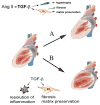Transforming growth factor (TGF)-β signaling in cardiac remodeling
- PMID: 21059352
- PMCID: PMC3072437
- DOI: 10.1016/j.yjmcc.2010.10.033
Transforming growth factor (TGF)-β signaling in cardiac remodeling
Abstract
Myocardial TGF-β expression is upregulated in experimental models of myocardial infarction and cardiac hypertrophy, and in patients with dilated or hypertrophic cardiomyopathy. Through its effects on cardiomyocytes, mesenchymal and immune cells, TGF-β plays an important role in the pathogenesis of cardiac remodeling and fibrosis. TGF-β overexpression in the mouse heart is associated with fibrosis and hypertrophy. Endogenous TGF-β plays an important role in the pathogenesis of cardiac fibrotic and hypertrophic remodeling, and modulates matrix metabolism in the pressure-overloaded heart. In the infarcted heart, TGF-β deactivates inflammatory macrophages, while promoting myofibroblast transdifferentiation and matrix synthesis through Smad3-dependent pathways. Thus, TGF-β may serve as the "master switchThis article is part of a special issue entitled "Key Signaling Molecules in Hypertrophy and Heart Failure". for the transition of the infarct from the inflammatory phase to formation of the scar. Because of its crucial role in cardiac remodeling, the TGF-β system may be a promising therapeutic target for patients with heart failure. However, efforts to translate these concepts into therapeutic strategies, in order to prevent cardiac hypertrophy and fibrosis, are hampered by the complex, pleiotropic and diverse effects of TGF-β signaling, by concerns regarding deleterious actions of TGF-β inhibition and by the possibility of limited benefit in patients receiving optimal treatment with ACE inhibitors and β-adrenergic blockers. Dissection of the pathways responsible for specific TGF-β-mediated actions and understanding of cell-specific actions of TGF-β are needed to design optimal therapeutic strategies. This article is part of a special issue entitled "Key Signaling Molecules in Hypertrophy and Heart Failure".
Copyright © 2010 Elsevier Ltd. All rights reserved.
Figures



Similar articles
-
MicroRNA-221/222 Family Counteracts Myocardial Fibrosis in Pressure Overload-Induced Heart Failure.Hypertension. 2018 Feb;71(2):280-288. doi: 10.1161/HYPERTENSIONAHA.117.10094. Epub 2017 Dec 18. Hypertension. 2018. PMID: 29255073
-
Fibroblast-specific TGF-β signaling mediates cardiac dysfunction, fibrosis, and hypertrophy in obese diabetic mice.Cardiovasc Res. 2024 Dec 14;120(16):2047-2063. doi: 10.1093/cvr/cvae210. Cardiovasc Res. 2024. PMID: 39373248 Free PMC article.
-
Endothelial Forkhead Box Transcription Factor P1 Regulates Pathological Cardiac Remodeling Through Transforming Growth Factor-β1-Endothelin-1 Signal Pathway.Circulation. 2019 Aug 20;140(8):665-680. doi: 10.1161/CIRCULATIONAHA.119.039767. Epub 2019 Jun 10. Circulation. 2019. PMID: 31177814
-
The role of TGF-beta signaling in myocardial infarction and cardiac remodeling.Cardiovasc Res. 2007 May 1;74(2):184-95. doi: 10.1016/j.cardiores.2006.10.002. Epub 2006 Oct 7. Cardiovasc Res. 2007. PMID: 17109837 Free PMC article. Review.
-
TGF-β as a therapeutic target in the infarcted and failing heart: cellular mechanisms, challenges, and opportunities.Expert Opin Ther Targets. 2024 Jan-Feb;28(1-2):45-56. doi: 10.1080/14728222.2024.2316735. Epub 2024 Feb 19. Expert Opin Ther Targets. 2024. PMID: 38329809 Review.
Cited by
-
Global phosphoproteomic profiling reveals perturbed signaling in a mouse model of dilated cardiomyopathy.Proc Natl Acad Sci U S A. 2016 Nov 1;113(44):12592-12597. doi: 10.1073/pnas.1606444113. Epub 2016 Oct 14. Proc Natl Acad Sci U S A. 2016. PMID: 27742792 Free PMC article.
-
Hypoxia-induced miR-210 modulates the inflammatory response and fibrosis upon acute ischemia.Cell Death Dis. 2021 May 1;12(5):435. doi: 10.1038/s41419-021-03713-9. Cell Death Dis. 2021. PMID: 33934122 Free PMC article.
-
Inflammation in cardiac injury, repair and regeneration.Curr Opin Cardiol. 2015 May;30(3):240-5. doi: 10.1097/HCO.0000000000000158. Curr Opin Cardiol. 2015. PMID: 25807226 Free PMC article. Review.
-
Beneficial Effects of Dietary Nitrite on a Model of Nonalcoholic Steatohepatitis Induced by High-Fat/High-Cholesterol Diets in SHRSP5/Dmcr Rats: A Preliminary Study.Int J Mol Sci. 2022 Mar 8;23(6):2931. doi: 10.3390/ijms23062931. Int J Mol Sci. 2022. PMID: 35328352 Free PMC article.
-
Different Roles of Resident and Non-resident Macrophages in Cardiac Fibrosis.Front Cardiovasc Med. 2022 Mar 7;9:818188. doi: 10.3389/fcvm.2022.818188. eCollection 2022. Front Cardiovasc Med. 2022. PMID: 35330948 Free PMC article. Review.
References
-
- Schiller M, Javelaud D, Mauviel A. TGF-beta-induced SMAD signaling and gene regulation: consequences for extracellular matrix remodeling and wound healing. J Dermatol Sci. 2004;35:83–92. - PubMed
-
- Annes JP, Munger JS, Rifkin DB. Making sense of latent TGFbeta activation. J Cell Sci. 2003;116:217–24. - PubMed
-
- Koli K, Saharinen J, Hyytiainen M, Penttinen C, Keski-Oja J. Latency, activation, and binding proteins of TGF-beta. Microsc Res Tech. 2001;52:354–62. - PubMed
-
- Murphy-Ullrich JE, Poczatek M. Activation of latent TGF-beta by thrombospondin-1: mechanisms and physiology. Cytokine Growth Factor Rev. 2000;11:59–69. - PubMed
Publication types
MeSH terms
Substances
Grants and funding
LinkOut - more resources
Full Text Sources
Other Literature Sources
Miscellaneous

